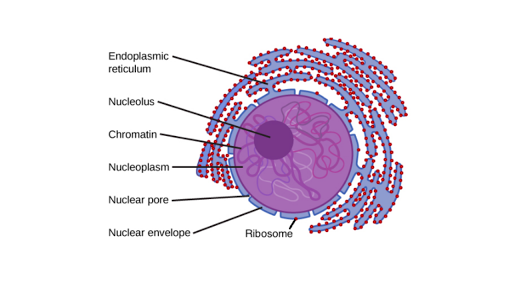What Best Describes the Nature of the Nuclear Membrane
This double membrane shields the nucleus and its contents from. However nuclear envelope ruptures and membrane blebs have also been observed in the absence of nuclear lamina gaps.

Nucleus And Ribosomes Article Khan Academy
The nuclear membrane is composed of the outer membrane the inner membrane and nuclear pores.

. Which of these best describes the nuclear membrane. The nuclear membrane does contain openings known as nuclear pores. The plasma membrane also called the cell membrane is the membrane found in all cells that separates the interior of the cell from the outside environment.
Cell membrane is a continuous membrane without any pores. Therefore nuclear membrane only occurs in eukaryotic cells. A cell membrane that is too solid will not perform its transport function.
What best describes the nature of the nuclear membrane. Nuclear Membrane - The nuclear envelope sometimes called a nuclear membrane is a structure made of lipids that has the hereditary material of the Eukaryotic cells. Its composed of an inner membrane and an outer membrane separated by the perinuclear space.
Are plant cell walls chemically similar to prokaryotic cell walls. The nuclear membrane envelops the nucleoplasm of the cell and acts as a barrier between the nuclear DNA and the cytoplasm. Nuclear membrane is defined as the two lipid bi layer membrane which surrounds the genetic material and nucleolus of the eukaryotic cell.
They are generally harmful. We call these inner and outer membranes. What are the parts of the nuclear membrane.
The nuclear membrane is also known as the nuclear envelop. How are the same or different. Figure 12 What best describes the part of the ATP molecule labeled B above.
ER and the cell membrane. Different surfaces are equal distances from the cell membrane. Are plant cell walls chemically similar to prokaryotic cell walls.
It allows all molecules to pass across it into the nucleus. The composition of the nuclear membrane network is complex and incompletely understood but it provides a structural framework to support and protect the nucleus. Trans-surface is towards the cell membrane.
They are limited to living in a few habitats. The plasma membrane consists of a lipid bilayer that is semipermeable. What best describes the chemical attraction illustrated above.
It contains pores that allow only certain molecules to pass. Choose the correct answer. The main feature of the nuclear membrane is the presence of two lipid bilayer structures in the membrane.
Cis-surface is towards the cell membrane. The nuclear membrane does not perform endocytosis and exocytosis but does have transport pores The nuclear envelope is a double layer consisting of two lipid bilayers that are folded together while the plasma membrane consists of a single lipid bilayer. A double phospholipid bilayer.
In bacterial and plant cells a cell wall is attached to the plasma membrane on its outside surface. They are uncommon in nature. Nuclear membrane is a discontinuous membrane with complex pores.
It is identical in composition to the cell membrane. Medial-surface is towards the cell membrane. How are they the same or different.
What best describes the nature of the nuclear membrane. Nuclear envelope refers to a double membrane structure that surrounds the nucleus in eukaryotic cells and provides this compartmentalization. A nuclear membrane 2 Which of the following statements best describes most bacteria.
Proteins that interact with the nuclear membrane are. What best describes the nature of the nuclear membrane. Which option below shows the correct order from smallest.
The nuclear membrane is the biological membrane that surrounds the nucleus. They may thus generally arise when the nuclear membranes peel off the. What term below best describes an ATP molecule.
The nuclear membrane includes an array of small holes or pores that permit the passage of certain materials such as nucleic acids and proteins between the nucleus and cytoplasm. ER and the cell membrane. These pores are comprised of several different proteins that function to regulate what molecules can pass into the nucleus.
Nature of the Membrane and Pores. They are very common in the environment. Nuclear membrane refers to a double membrane enclosing a cell nucleus and having its outer part continuous with the endoplasmic reticulum.
The nuclear membrane is a two-layered structure that protects the nucleus keeps DNA separate from the rest of the cell and manages what materials enter the nucleus. A plasma membrane e. A nuclear membrane b.
A nuclear membrane or envelope surrounds every nucleus. By understanding nuclear membrane function in a cell will help us to become more aware about the important role it plays in functioning of our bodies. All of the above a.
Ribonucleoproteins RNA and various proteins can move through these pores both into and out of the nucleus. Atoms macromolecules viruses prokaryotic cells eukaryotic cells. Golgi apparatus is oriented to that its.
No Plant cell walls are made of cellulose and bacterial cell walls are made of peptidoglycans. A double phospholipid bilayer. It is rigid and impermeable.
A nuclear membrane is a double membrane that encloses the cell nucleus. The nucleus is surrounded by a nuclear envelope which is a double membrane comprised of an outer membrane and an inner membrane. One or more chromosomes d.
Lysosomes and the cell membrane. It serves to separate the chromosomes from the rest of the cell.

Bacteria Cell Structure Under Attack Cell Structure Bacterial Cell Structure Plasma Membrane

Cell Biology Cells Tissues Organs Systems Cells And Tissues Tissue Biology Cell Biology

Quiz Which Astrological Sign Are You Really Astrology Signs Astrology And Horoscopes Astrology

Function Structure And Composition Of The Cell Membrane Cell Membrane Plasma Membrane Cell Membrane Structure
No comments for "What Best Describes the Nature of the Nuclear Membrane"
Post a Comment